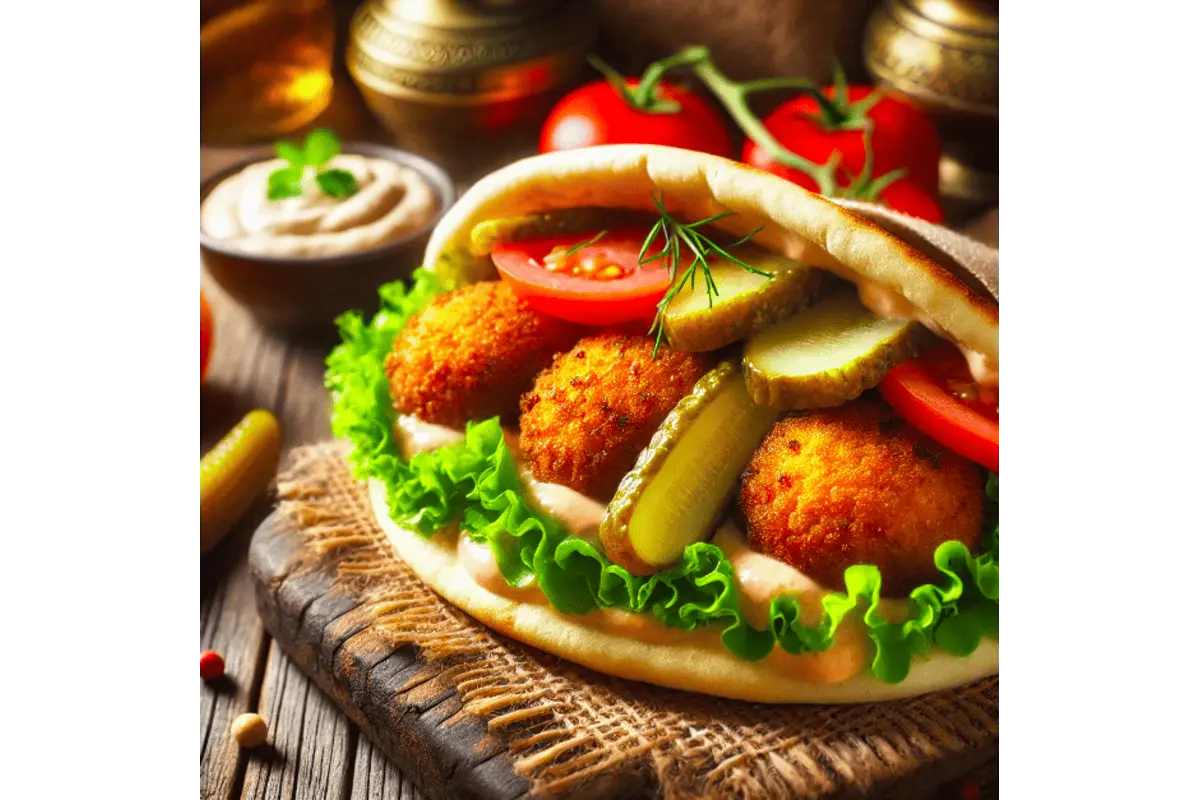Introduction to Fried Mediterranean Food
Mediterranean cuisine is a celebration of flavor, history, and health. At the heart of this culinary tradition lies a love for fried dishes, which are as diverse as the countries in the region. From the crispy falafel of the Middle East to golden fried sardines from coastal Spain and Greece, every bite tells a story of heritage and innovation.
Fried Mediterranean foods aren’t just about taste—they’re about culture. These dishes bring families together, enhance festivities, and offer a connection to the past. For those looking for lighter Mediterranean meal options, you can explore healthy Mediterranean alternatives to pasta, which pair beautifully with fried foods.
To fully appreciate these dishes, understanding their roots and preparation is essential. For a deeper dive into Mediterranean cooking and its health benefits, check out the Mediterranean Diet Overview, which explains why this cuisine is cherished worldwide.
Table of Contents
The Rich History of Fried Mediterranean Food
Frying, as a cooking technique, has ancient roots in the Mediterranean. The use of olive oil, a regional treasure, dates back thousands of years and is pivotal in Mediterranean cooking. Unlike many modern oils, olive oil not only enhances flavors but also provides health benefits, making it a staple in these Fried Mediterranean Food.
From humble beginnings, frying evolved to become a symbol of celebration and innovation. Iconic dishes like arancini in Italy or falafel in the Middle East were born out of necessity and resourcefulness. These dishes, often using simple ingredients like leftover rice or chickpeas, became symbols of culinary creativity. For a variety of recipes that highlight this ingenuity, check out Mediterranean Living, a hub for authentic Mediterranean flavors.
Popular Fried Mediterranean Food
Iconic Fried Mediterranean Food
The Mediterranean region overflows with culinary treasures, offering a wide array of iconic fried dishes cherished for generations. These recipes captivate with their bold flavors and crispy textures, securing their place as staples in both homes and restaurants across the region. Every dish reflects a blend of tradition and innovation, highlighting the Mediterranean’s unmatched skill in frying techniques. By transforming simple ingredients into irresistible creations, these dishes embody the rich culinary heritage and creativity of the region.
Falafel: The Vegetarian Delight
Falafel stands out as one of the most iconic Fried Mediterranean Food, earning love from food enthusiasts worldwide. Made by blending ground chickpeas or fava beans with garlic, cumin, parsley, and other aromatic spices, these crispy patties burst with flavor. Cooks shape the mixture into small balls or flattened discs before frying them to a golden brown perfection. Each bite combines a satisfying crunch with a flavorful, herbaceous interior that keeps people coming back for more.
Traditionally, falafel pairs beautifully with tahini sauce or nestles perfectly into a pita alongside fresh vegetables, creating a simple yet delicious meal. Its versatility has propelled it to global fame, inspiring creative adaptations such as falafel burgers, wraps, and even salad bowls. Whether enjoyed as a snack, appetizer, or main course, falafel continues to delight palates and showcase the enduring appeal of Mediterranean cuisine.
Fried Calamari: A Seafood Staple
Fried calamari delights seafood enthusiasts and shines as a highlight on Mediterranean menus. Cooks lightly coat tender squid rings in a seasoned flour mixture before frying them to golden, crispy perfection. This preparation creates a delightful contrast between the delicate texture of the squid and the richness of the dish. For an added burst of flavor, many serve fried calamari with tangy accompaniments such as aioli, marinara sauce, or a fresh squeeze of lemon juice. This dish stands out as a favorite appetizer in Mediterranean restaurants and a popular snack at seaside cafes, especially in Greece and Italy.
Arancini: Sicily’s Golden Treat
Spanakopita, a beloved Greek pastry, typically uses flaky phyllo dough filled with spinach, feta cheese, onions, and herbs. However, many cooks have embraced a fried version that adds an irresistible crunch. This variation transforms the dish into smaller, more portable rolls, making them ideal for snacks or appetizers. To enhance the experience, serve these bite-sized treats with a creamy yogurt-based dip. The dip perfectly balances the savory, cheesy filling and the crispy phyllo exterior, creating a delightful harmony of textures and flavors. This twist on the classic recipe not only delivers extra crunch but also makes spanakopita even more versatile and crowd-pleasing.
Spanakopita Rolls: A Greek Classic with a Twist
Traditionally baked, spanakopita is a Greek pastry made with flaky phyllo dough and a filling of spinach, feta cheese, onions, and herbs. However, a fried version of spanakopita has emerged as a delicious variation, providing an extra layer of crunch. The fried rolls are smaller and more portable, making them perfect for snacks or appetizers. These bite-sized treats are often paired with a creamy yogurt-based dip, which complements the savory, cheesy filling and the crispy phyllo exterior.
Fried Sardines: Coastal Simplicity
Fried sardines are a coastal favorite, particularly in Spain, Greece, and Portugal. These small fish are cleaned, seasoned with a simple mix of salt, lemon, and herbs, and then fried whole. The result is a dish that is crispy on the outside and tender on the inside, with a flavor that highlights the freshness of the fish. Fried sardines are often served as a tapa or appetizer, accompanied by a wedge of lemon and a side of crusty bread. Their simplicity and bold taste make them a quintessential Mediterranean dish.
Additional Fried Mediterranean Food Across the Region
While the dishes above represent some of the most iconic fried foods, the Mediterranean offers many other specialties worth exploring:
- Croquettes: Found in Spain and other parts of the Mediterranean, croquettes are creamy, béchamel-based fritters often filled with ham, cheese, or cod. They’re coated in breadcrumbs and fried until golden brown.
- Kibbeh: A Middle Eastern specialty, kibbeh consists of fried bulgur and ground meat, often stuffed with spiced lamb or beef. These torpedo-shaped bites are packed with rich, savory flavors.
- Brik: A North African dish, brik is made by wrapping a thin dough around fillings like egg, tuna, or minced meat, then frying it to create a crispy, flaky shell.
Each of these dishes highlights the Mediterranean’s love for fried foods and its ability to transform local ingredients into extraordinary culinary experiences. Whether you’re savoring crispy calamari at a coastal café or enjoying falafel at a bustling street market, the Mediterranean’s fried foods offer a delightful taste of its rich culinary heritage.
How to Make Authentic Falafel: A Classic Fried Mediterranean Food

Making falafel at home may seem daunting, but with a little preparation and patience, you can recreate this iconic Mediterranean dish in your own kitchen. Let’s break it down step by step.
Ingredients
- 2 cups dried chickpeas (soaked overnight, not canned)
- 1 medium onion, chopped
- 4 garlic cloves, minced
- 1 cup fresh parsley, chopped
- 1 cup fresh cilantro, chopped
- 2 teaspoons ground cumin
- 1 teaspoon ground coriander
- 1 teaspoon baking soda
- 1 teaspoon salt (adjust to taste)
- ½ teaspoon black pepper
- ½ teaspoon cayenne pepper (optional, for a spicy kick)
- 3 tablespoons all-purpose flour (or chickpea flour for a gluten-free option)
- Vegetable oil or olive oil for frying
Instructions
- Prepare the Chickpeas
After soaking the chickpeas overnight, drain them well. Using soaked, uncooked chickpeas is essential because canned chickpeas will result in a mushy texture. - Blend the Mixture
In a food processor, combine the chickpeas, onion, garlic, parsley, and cilantro. Pulse until the mixture is coarse but well-blended. Be careful not to overprocess; the mixture should hold together but not become a paste. - Season the Mixture
Add cumin, coriander, baking soda, salt, black pepper, and cayenne pepper (if using). Mix everything thoroughly. Sprinkle in the flour and mix again until the mixture binds together easily. If it’s too dry, you can add a teaspoon of water at a time. - Chill the Dough
Transfer the mixture to a bowl and refrigerate for 1-2 hours. This step helps firm up the mixture, making it easier to shape. - Shape the Falafel
Using your hands or a falafel scoop, form the mixture into small balls or patties, about the size of a walnut. - Heat the Oil
In a deep pan or pot, heat about 2 inches of vegetable oil or olive oil over medium heat. Test the oil by dropping a small piece of the falafel mixture into it; it should sizzle and float to the top. - Fry the Falafel
Gently lower the falafel balls into the hot oil, cooking in batches to avoid overcrowding. Fry for 3-4 minutes per batch, turning occasionally, until the falafel is golden brown and crispy. - Drain and Serve
Use a slotted spoon to transfer the falafel to a plate lined with paper towels. This will absorb excess oil and keep the falafel crispy.
Falafel: Versatility at Its Best
Falafel offers incredible versatility, making it a staple in Mediterranean cuisine and kitchens worldwide. With its crispy exterior and flavorful interior, it pairs beautifully with countless sides and accompaniments. This adaptability ensures it works seamlessly in diverse meal plans, accommodates various dietary preferences, and enhances any culinary occasion. Whether served as a quick snack, a hearty main dish, or a creative addition to a fusion menu, falafel effortlessly brings vibrant Mediterranean flavors to the table.
Classic Pairing: The Timeless Pita Pocket
For a truly authentic experience, serve falafel in a warm pita pocket. Start by layering the pita with crisp lettuce, juicy slices of tomato, and tangy pickles for a burst of freshness. Drizzle generously with creamy tahini sauce or a dollop of tzatziki to enhance the flavor and add a luscious texture. This combination creates a satisfying handheld meal that is both filling and flavorful, perfect for lunch, dinner, or even as street food at a Mediterranean-inspired gathering.
Light Option: A Fresh and Healthy Twist
If you’re looking for something lighter, falafel pairs wonderfully with a side of fresh tabbouleh salad. This herby, lemony salad made with parsley, mint, bulgur, and fresh vegetables provides a refreshing contrast to the crispy falafel. For a creamier option, serve it alongside a bowl of silky-smooth hummus. Dip each bite of falafel into the hummus for an irresistible combination of textures and flavors. These lighter pairings are perfect for those seeking a wholesome, plant-based meal that doesn’t compromise on taste.
Keto-Friendly Twist: Low-Carb Delights
For those following a keto or low-carb lifestyle, falafel can be adapted to suit dietary needs. Skip the traditional pita bread and instead serve the falafel over a bed of mixed greens or zucchini noodles for a fresh and vibrant presentation. Pair it with a tangy yogurt-based dressing or a drizzle of olive oil and lemon juice. To explore more low-carb options, try incorporating falafel into a meal inspired by keto-friendly Mediterranean recipes. This twist allows you to enjoy all the flavors of falafel while staying within your dietary goals.
Whether you prefer the comfort of a pita pocket, the lightness of a salad, or the adaptability of a keto-friendly dish, falafel’s versatility ensures it can be tailored to suit any occasion or preference. Its ability to complement a variety of flavors and textures makes it a beloved dish across cultures and cuisines.
Pairing Fried Mediterranean Food with Sides and Drinks
To elevate your experience, pairing fried Mediterranean foods with the right sides and beverages is essential. These accompaniments complement the bold flavors while balancing the richness of the fried dishes.
Ideal Side Dishes
- Tabbouleh Salad: A fresh, herby salad made with parsley, mint, and bulgur wheat.
- Hummus and Pita: A creamy chickpea dip served with warm pita bread.
- Pickled Vegetables: These tangy and crunchy treats cut through the oiliness of fried foods.
Perfect Drink Pairings
- Mint Lemonade: Refreshing and zesty, ideal for balancing rich flavors.
- Red or White Wine: Choose a light white wine for seafood dishes and a medium-bodied red for falafel or arancini.
- Iced Herbal Teas: Mint or chamomile tea pairs beautifully with Mediterranean spices.
Explore these pairings with the help of healthy alternatives to pasta, which provide ideas for complete, balanced meals.
Conclusion
Fried Mediterranean food embodies the region’s love for flavor, health, and innovation. Whether you’re enjoying falafel or experimenting with modern twists like air-fried arancini, these dishes provide a delicious connection to Mediterranean culture. By focusing on quality ingredients and sustainable practices, you can enjoy these foods guilt-free. Let the Mediterranean inspire your next culinary adventure!

